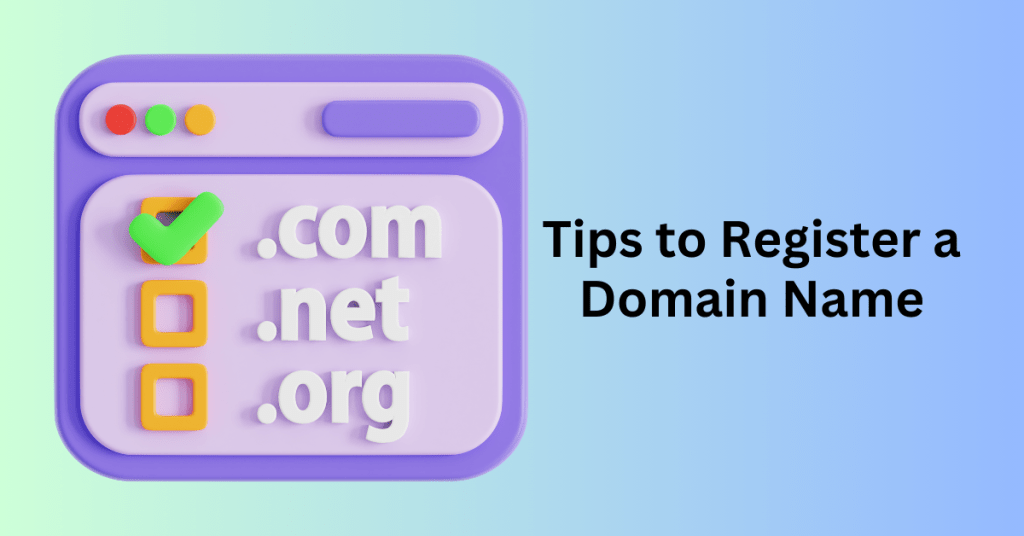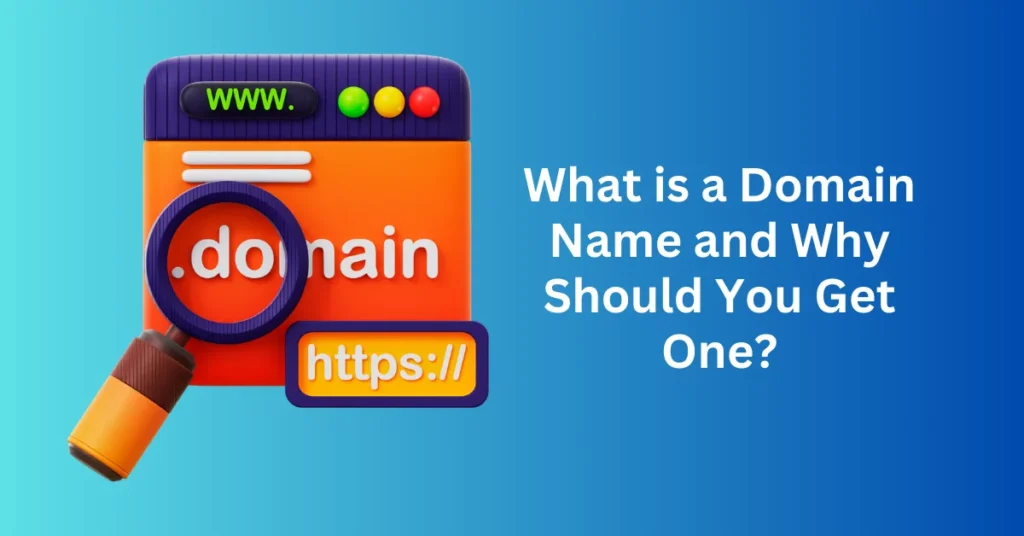A domain name serves as a unique and memorable web address, allowing users to identify and access specific websites on the internet. Composed of a name paired with a top-level domain (TLD)—such as “example.com”—domain names simplify the process of navigating the web by eliminating the need to memorize complex numerical IP addresses.
Domain names are undeniably one of the most crucial components of any website and the broader infrastructure of the internet. This seemingly small element of the World Wide Web is what enables you to visit your favourite online stores and blogs. Without domain names, browsing the internet would resemble a complex algebraic equation, and establishing an online presence would be a daunting task.
If you’re considering building any type of online presence—be it launching an e-commerce store or showcasing your professional portfolio to attract potential employers—it’s essential to understand the fundamentals of domain names.
Your domain name significantly influences not only how people find your website but also how they perceive your brand before they even explore your offerings. As the saying goes, you only get one chance to make a first impression.
This comprehensive guide will teach you what a domain name is and how it functions. We will explore the basics of domain names, their roles in online navigation, and best practices for selecting and registering the ideal domain name for your needs. Feel free to skip ahead to any of the sections below.
Get Your Domain Name from a Reputable Domain Registrar
What is a Domain Name?

A domain name is a user-friendly, human-readable address that people type into a browser to reach a specific website. It functions like an online “fingerprint” that uniquely identifies each site. Domain names were developed to simplify access to a website’s Internet Protocol (IP) address, which is the numerical identifier that computers use to communicate.
Every IP address consists of a string of numbers. Typically, it includes four decimal numbers (ranging from 0 to 255) separated by periods. For instance, 172.217.3.196 represents one of Google’s IP addresses. While effective for machines, IP addresses are not easy for humans to remember. Domain names solve this problem by converting complex IPs into memorable, accessible labels, such as “google.com.”
The Internet Corporation for Assigned Names and Numbers (ICANN) is the central body overseeing the domain name system. ICANN allocates IP addresses, manages a centralized database of all domain names and their associated IPs, and maintains an accreditation system for registrars. These registrars are organizations authorized to register and manage domain names for the public. ICANN also oversees the creation and regulation of domain extensions, or Top-Level Domains (TLDs), such as “.com,” “.org,” and “.net.” It has the authority to approve new TLDs, ensure compliance with global internet standards, and, if necessary, deactivate domain extensions that violate set guidelines.
Difference Between a Domain Name and a URL
Although people sometimes use the term “domain name” interchangeably with “URL” (Uniform Resource Locator) or “web address,” these terms refer to distinct components of website navigation. A URL represents the complete address of a web page. It includes multiple elements beyond just the domain name itself.
For example, in the URL “https://www.bennietay.com/blog/”, “bennietay.com” is the domain name. However, the entire URL also includes the protocol (“https://”), a subdomain (“www”), and a path to a specific page (“/blog/article”).
The domain name consists of two essential parts: the website’s unique identifier or name (e.g., “bennietay”) and the domain extension (e.g., “.com”). Each component of a URL has a specific function. When combined, these components direct users precisely to a location within a website.
How Does Domain Name Work?
Domains serve as the navigational system for the internet. They allow users to access websites through memorable names instead of numerical IP addresses. The internet itself is a vast, interconnected network of computers worldwide. This network is connected through a global system of underground and submarine cables.
Each device in this network, from personal computers to large web servers, has an IP address. An IP address is a unique set of numbers that identifies each device. It enables communication with other devices to transmit and retrieve data.
Since IP addresses (such as 192.168.1.1) can be challenging for users to remember, domain names provide a more intuitive and user-friendly alternative. Domain registrars effectively map domain names to IP addresses, simplifying navigation. However, this process requires converting domain names back into IP addresses. The Domain Name System (DNS) handles this conversion.
When a user types a domain name into their browser, the browser sends a request to DNS servers. These servers act as a directory to find the associated IP address. The DNS servers locate the name servers linked to that domain name. The website’s hosting provider typically manages these name servers.
The name servers then direct the request to the specific web server that holds the website’s files. Once the system identifies the IP address, the web server retrieves the files and data linked to that IP and sends them back to the browser. This process displays the website for the user.
This entire sequence, from entering a domain name to loading a webpage, takes place within seconds. It showcases the efficiency and speed of the DNS infrastructure. Sometimes, DNS servers and web servers are collectively referred to as “domain servers.” They work together to process domain requests and deliver web content.
The difference between Domain Name and Web Hosting
To build and publish a website, you need both a domain name and web hosting. Each plays a unique and interdependent role in creating a functional online presence. Many people confuse their purposes because service providers often bundle them together.
Think of your website as an apartment complex, where each “apartment” represents a different page of your site. For this building to exist, you need land to construct it on. In the digital world, this “land” is known as web hosting. Web hosting provides the space where all your website’s files and data are stored on web servers. These servers deliver this information to visitors when they access your site.
However, for people to reach your site, they need an address. You could share the IP address of the server hosting your site, but that would be like giving someone geographic coordinates instead of a street address—technically feasible but impractical. This is where domain names come into play. A domain name serves as the address of your “apartment complex,” guiding visitors directly to your site through an easy-to-remember name.
To direct someone to a specific page within your site, you simply add a path after your domain name, like “/blog.” This is similar to adding an apartment number to a building address, guiding visitors to a specific section of your website.
The internet itself acts as the network or “street” connecting users to your virtual apartment complex. It allows people worldwide to reach your site by typing in its domain name and finding it hosted on the web server. Together, domain names and web hosting form the foundational elements of a website’s infrastructure.
Different types of Domain Name
The Domain Name System (DNS) functions as an organized hierarchy to manage and resolve domain names. This structure allows for a systematic and flexible naming system. At the top of this hierarchy is the root domain, represented by a dot (“.”). Below this root, domains are arranged into different levels, each serving a specific purpose.
The primary types of domains include:
- Top-Level Domains (TLDs): These are the highest level in the hierarchy, typically found at the end of a domain name (e.g., “.com,” “.org,” “.net”). They categorize domains based on their type or purpose.
- Second-Level Domains (SLDs): These sit directly below the TLDs and usually represent the name of the organization or website (e.g., “example” in “example.com”).
- Third-Level Domains (Subdomains): These are additional subdivisions under a second-level domain, often used to organize or categorize different sections of a website (e.g., “blog” in “blog.example.com”).
Together, these components create a structured and manageable system for navigating the vast landscape of the internet.
Top-level domains (TLD)
A Top-Level Domain (TLD), also called a domain extension, is the final segment of a domain name located after the last dot, such as “.com” in “example.com.” TLDs help convey details about a website’s purpose or geographic region. By August 2022, there were 1,487 TLDs available, including traditional options and new additions. The main categories are:
- Generic Top-Level Domains (gTLDs): These are open for registration by anyone and include well-known options like .com, .org, and .net, as well as more specialized extensions like .biz, .store, .site, and .blog. Introduced by ICANN’s new gTLDs program, they now include over a thousand unique extensions catering to various industries and interests, such as .yoga, .photos, .tech, .ninja, and .xyz.
- Sponsored Top-Level Domains (sTLDs): Sponsored by specific organizations or agencies, sTLDs have more restricted registration criteria and are regulated by the entities that support them. Examples include .gov (reserved for U.S. government entities) and .edu (for accredited educational institutions).
- Country Code Top-Level Domains (ccTLDs): These two-letter extensions represent specific countries, such as .ca (Canada), .fr (France), and .jp (Japan). Originally intended for entities operating within a particular country, some ccTLDs have gained popularity across industries for branding purposes—e.g., .ai for artificial intelligence or .gg for gaming. There are 308 ccTLDs currently available.
Second-level domains (SLDs)
The Second-Level Domain (SLD) is the portion of a domain name that appears immediately to the left of the TLD. It is often the brand or website name, such as “bennietay” in “bennietay.com.” For certain ccTLDs, SLDs add an extra layer of organization, with SLDs used to signify specific site types. For example:
- Commercial Websites: .co.uk (United Kingdom), .com.mx (Mexico)
- Educational Institutions: .ac.uk (United Kingdom), .edu.es (Spain)
These country-specific SLD structures help indicate the purpose and scope of the website within that region, effectively combining the SLD with the TLD to represent a clear, region-specific domain.
Third-level domains
A Third-Level Domain, commonly known as a subdomain, is an additional prefix added to a domain name. This prefix creates a unique and separate section of the website, often tailored for specific purposes. Subdomains enable distinct sites to coexist under the same domain, such as a blog or an online store. They typically follow a format like blog.example.com.
Some subdomains provide free domain services. For example, Wix structures its free website URLs as username.wixsite.com/sitename. When you own a domain name, you have the flexibility to create custom subdomains as needed. This allows you to connect different sections of your site, such as shop.example.com for an online store.
In some cases, domains can have even more levels to accommodate complex site structures. This results in four- or five-level domains, such as news.bbc.co.uk or www.village.fairport.ny.us. While there is no formal limit on the number of levels a domain can have, domains with more than four levels are relatively uncommon.
How to choose a Domain Name
In Verisign’s late 2022 industry report, it was reported that nearly 349.9 million domain names were registered across various top-level domains. Each day, thousands of new registrations occur. To find an available domain name that effectively represents your brand or idea, you need a combination of creativity, SEO awareness, strategic planning, and an understanding of best practices. This guide will assist you in selecting a domain name that is not only memorable but also aligned with your brand and effective in enhancing your online visibility. Here are three critical steps to help you get started:
1. Make Your Domain Name Easy to Type and Pronounce
A successful domain name should be easy to type and pronounce. If you’ve ever struggled with spelling or pronouncing an unusual name, you understand how quickly it can be forgotten or misspelt. Domain names that are difficult to type or pronounce create similar challenges. This can frustrate visitors and lead to missed opportunities.
Avoid using complex or commonly misspelt words, such as “anemone” or “croissant.” Also, steer clear of homophones or abbreviations, like “ok” and “okay,” that could cause confusion.
After brainstorming a few options, test them with friends or colleagues. Ensure they are easy to type and pronounce. Ask them to repeat the name a day or two later to see if it stuck in their memory. If they struggle, consider simplifying your choice.
2. Keep Your Domain Name Aligned with Your Brand
Your domain name should clearly represent your brand. Using your brand name as your domain is ideal, as it strengthens brand recognition and helps people find you easily. If someone has taken your brand name, consider adding a relevant keyword to keep it unique and search-friendly. For example, if your ideal domain for a plant nursery named “Green Sprouts” is unavailable, you could try alternatives like “GreenSproutsPlants.com” or “ShopGreenSprouts.com.”
It’s a smart practice to secure your domain as soon as you decide on a business name to avoid potential conflicts. Using a domain name generator can simplify this process by suggesting available names related to your brand or by showing options using keywords relevant to your industry.
3. Choose the Right Domain Extension
Your choice of domain extension impacts both the perception and cost of your domain name. The most recognized and trusted domain extension is “.com,” often seen as the standard for credibility and memorability according to a study by GrowthBadger. While extensions like .net or .info are available options, consider how they might be perceived by your target audience. Some extensions, such as .org, serve specific purposes, like representing non-profits, and may not align well with your brand if you operate a commercial site.
Pricing for domain extensions can vary widely, so weigh your options carefully. If the extension you prefer is more costly or unavailable, look into other options that convey professionalism and trust while staying aligned with your brand’s identity.
Get Your Domain Name from a Reputable Domain Registrar
Why do you need a Domain Name?
A domain name is essential for building a professional, credible, and recognizable online presence. Here are the key reasons why securing a custom domain name is crucial for your brand:
1. Enhances Brand Professionalism and Credibility
A custom domain name, such as “www.yourbusiness.com,” conveys a sense of professionalism and legitimacy that a generic, free-hosting subdomain (e.g., “yourbusiness.freehostingsite.com”) simply cannot. Having a dedicated domain name communicates to visitors that your brand is established, trustworthy, and invested in delivering quality.
2. Reinforces Brand Identity and Recognition
A domain that matches your business name reinforces your brand identity. It makes it easier for customers to remember and find you online. By aligning your domain with your business name, you create a seamless branding experience. This consistency remains across marketing channels and online searches. Consistency is key for brand recall. It helps customers and clients associate your domain with your services and products.
3. Provides Full Control Over Your Online Presence
Owning your domain gives you complete authority over your website and online presence. You can set up custom email addresses, such as “yourname@yourbusiness.com.” This further reinforces your brand’s professionalism. Additionally, you gain full control over your website’s content, design, and user experience. This ensures that your brand is represented exactly as you envision it.
4. Simplifies Promotion and Marketing Efforts
A custom domain simplifies promoting your website across various marketing channels. This includes social media, email campaigns, business cards, and advertisements. A memorable domain name helps you reach a wider audience and increases the chances of repeat visitors. Furthermore, a strong domain is easier to share and more likely to be clicked on. This can significantly improve your overall web traffic and engagement.
5. Protects Your Brand and Mitigates Competition
Registering and regularly renewing your domain name protects your brand and online reputation by preventing others from using it. This is particularly crucial in competitive industries, where securing your unique domain stops competitors from capitalizing on your name or confusing potential customers. A registered domain not only helps you stand out from the competition but also offers peace of mind, knowing that your brand identity is secure.
Investing in a domain name lays a solid foundation for your online brand. It enhances your credibility and positions you for long-term growth and success in the digital landscape.
How to buy a Domain Name

Once you’ve settled on a domain name that aligns with your brand, it’s time to officially register it. The process is straightforward but requires some careful consideration to ensure your domain registration supports your website’s long-term success. Here are the key steps to make it official:
1. Do a Domain Name Search
Before registering, you’ll want to confirm that your desired domain is available. While manually searching each variation is possible, it’s much more efficient to use a domain name search tool. These tools quickly show whether your preferred domain is taken and often suggest similar alternatives if it’s unavailable. They also allow you to view and compare prices across domain options so you can make an informed choice that aligns with your budget.
2. Choose a Domain Name Registrar
After confirming availability, the next step is to select a domain registrar. A domain registrar is a service provider responsible for registering and managing your domain on your behalf. Here are key factors to consider:
- Pricing and Renewal Costs: Look closely at initial registration fees as well as renewal costs. Many registrars offer introductory pricing, followed by higher renewal rates. Others provide more consistent pricing. Knowing what to expect long-term can help avoid unexpected expenses.
- Customer Support and Privacy Protection: Reliable support and privacy options can be essential for smooth domain management. Look for registrars that offer quality support to assist with any issues and provide options for WHOIS privacy protection to keep your personal information secure.
- Add-ons and Services: Some registrars bundle additional features, like security tools or website builders, which can save you time and effort. For instance, registrars that offer a personalized email service tied to your domain (e.g., “yourname@yourbusiness.com”) add a professional edge to your brand’s communications.
3. Evaluate Additional Domain Management Considerations
Choosing a registrar is more than just about the price and availability of your domain; it’s about ensuring long-term stability and flexibility for your online brand. Consider the following additional points:
- Domain Age: Understanding domain age can be valuable, especially if you’re acquiring an older domain. Older domains may offer certain SEO benefits due to established history, brand trust, or prior traffic. However, it’s also wise to check domain history to ensure there are no negative associations.
- Domain Email Integration: If you’re considering business emails that reflect your domain name (like “info@yourbusiness.com”), prioritize registrars that offer email hosting. This simplifies setup and maintains consistency across your web properties.
- Bulk Purchasing Options: If you’re considering expanding to new regions or creating specialized sub-brands, bulk purchasing of domain names is worth considering. Many registrars offer discounts on bulk domain purchases, allowing you to register multiple domains for future business expansions.
4. Secure Your Domain for the Long Term
Registering a domain isn’t a one-time process. Once you’ve purchased your domain, renewing it annually is necessary to maintain ownership. Some registrars allow you to register a domain for multiple years upfront, which can provide peace of mind and save time.
Get Your Domain Name from a Reputable Domain Registrar
How to Secure a Domain Name
Securing your domain name is essential to maintaining control over your online presence and protecting your brand from potential threats. Here are best practices to ensure your domain remains secure and under your control:
1. Use a Reputable Domain Name Registrar
Select a well-established and reputable domain registrar known for strong security measures and reliable customer service. A trusted registrar will have a proven track record of safeguarding customers’ domains and should provide robust security options like WHOIS privacy protection, domain locking, and easy-to-navigate management tools. Review the registrar’s policies on data privacy and look for transparency in pricing to avoid unexpected fees.
2. Set a Strong, Unique Password
Create a strong and unique password for your domain registrar account. Your password should be at least 12 characters long and include a mix of uppercase and lowercase letters, numbers, and special characters. Avoid reusing passwords from other accounts, as this can increase your vulnerability to security breaches.
To effectively manage and store complex passwords, consider using a reputable password manager. This tool securely stores your login credentials and reduces the risk associated with weak password choices. By using a password manager, you can create complex passwords without the worry of forgetting them.
3. Enable Two-Factor Authentication (2FA)
Two-factor authentication (2FA) is a critical security feature that requires a second form of verification, typically a code sent to your mobile device, in addition to your password. Enabling 2FA significantly reduces the risk of unauthorized access, even if someone obtains your password. Most reputable registrars offer this option, so make sure it’s activated in your account settings.
4. Keep Contact Information Up-to-Date
Ensure that your registrar account contains accurate and up-to-date contact information, including your primary email address and phone number. Having current details enables your registrar to quickly reach you if there’s any suspicious activity or an issue with your domain.
Additionally, make it a habit to periodically review and confirm this information. This is especially important if you change contact details or switch email providers. Keeping your contact information current helps protect your domain and ensures you remain informed about any critical updates.
5. Be Cautious of Phishing Emails and Scams
Phishing emails are fraudulent messages intended to trick you into revealing personal information, such as your registrar account password or payment details. It’s important to remain vigilant with emails or messages that seem to come from your domain registrar.
Avoid clicking on links or downloading attachments from unsolicited emails. Instead, always log in to your registrar’s website directly by typing the URL into your browser. This practice helps ensure that you’re accessing the legitimate site and not falling victim to a phishing attempt.
6. Enable Domain Locking
Many registrars offer a feature called domain locking to prevent unauthorized domain transfers. When you enable domain locking, it restricts others from transferring your domain to another registrar without your explicit authorization. This added layer of security helps prevent unauthorized changes and protects your domain from hijacking.
7. Safeguard Your Domain Registration Information
Treat your domain registration details with as much caution as other sensitive business information. Avoid sharing login credentials, contact information, or account access with anyone you don’t fully trust. If you must delegate domain-related tasks, limit access to the necessary minimum and consider using secure third-party tools for shared access, like team management features offered by some registrars.
8. Consider Enabling WHOIS Privacy Protection
WHOIS privacy protection is a feature that conceals your personal contact details from the publicly accessible WHOIS database. Without this protection, anyone can see your registered information, which increases your risk of receiving spam or being targeted by scams. Privacy protection prevents this exposure by replacing your information with generic contact details provided by the registrar, helping to shield your identity.
9. Regularly Monitor Domain Status and Renewals
Monitor your domain’s status periodically and check for any unauthorized updates. Most registrars offer domain status alerts, renewal reminders, and tools to help you monitor your account’s security settings. Set up automatic renewals to avoid accidental expiration, which could lead to domain loss or others potentially acquiring it.
10. Be Aware of Domain Expiration and Renewal Policies
Domain names must be renewed regularly, typically on an annual basis. Familiarize yourself with your registrar’s renewal policies and set reminders for renewal dates. Some registrars provide auto-renewal options that simplify the renewal process, ensuring you maintain control over your domain without interruption.
Final Thoughts: What is a Domain Name and Why Should You Get One?
Whether you’re here to explore how to purchase a domain for your website or simply out of curiosity, it’s essential to understand the crucial role domain names play in today’s digital landscape. The domain name industry in the U.S. is valued at an impressive $8.1 billion and is steadily growing. This growth includes domain trading, a profitable venture in which people buy domains with the intent of reselling them at a profit—often called “domain flipping.”
Once you secure a domain, it’s exclusively yours, provided you renew it on time. This exclusivity makes it essential to register the domain name for any business or personal brand you’re developing as early as possible. Your domain could be something straightforward like your name, or a highly marketable asset like “business.com,” which famously sold for $345 million. Registering and holding onto your domain name, known as “domain parking,” prevents others from claiming it and positions you to benefit from future value if your brand grows.


